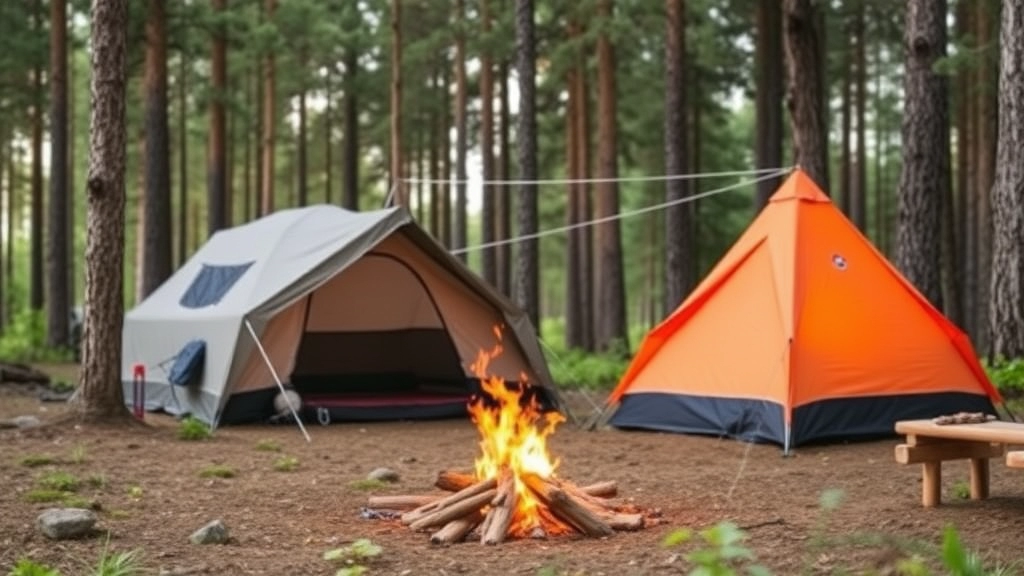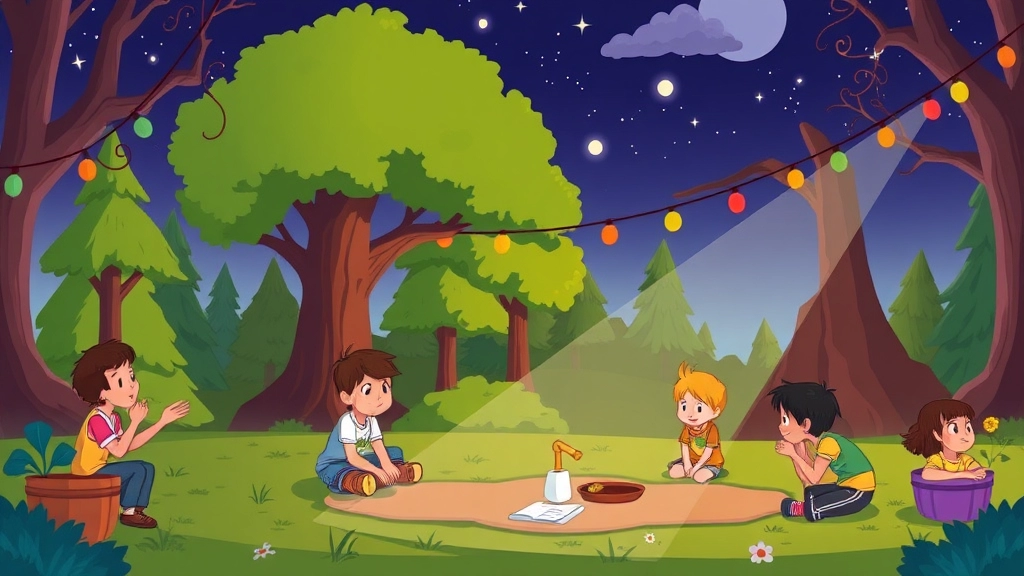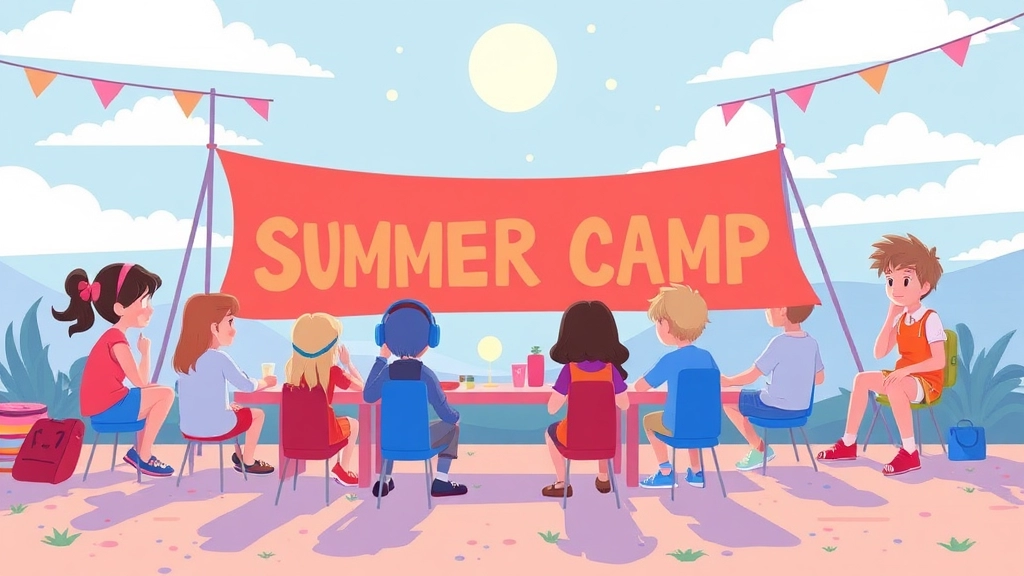Animation Summer Camp
Animation Summer Camp is more than just a fun way to spend the summer; it’s a gateway to a world of creativity and technical skills. This article dives into the various types of animation camps available, from traditional hand-drawn techniques to cutting-edge 3D modeling. We’ll explore key features to look for, the benefits of attending, and how to choose the right camp for your child, ensuring they get the most out of their experience.
You’ll also find insights into the skills and techniques taught, success stories of past participants, and a comparison between virtual and in-person camps. Whether you’re concerned about costs or preparing your child for their first day, this guide has you covered. Get ready to unlock your child’s potential with an animation summer camp that aligns with their interests and future goals.
Types of Animation Summer Camps
Alright, so you’re looking into animation summer camps, but where do you even start? There are a ton of options out there, and it can get pretty overwhelming. Let’s break it down and make it easy to digest.
Traditional Animation Camps
These camps focus on the classic, hand-drawn techniques. Think of Disney’s early days. If your kid loves sketching and wants to learn how to bring their drawings to life, this is the place to be.
Digital Animation Camps
Here, it’s all about using software like Adobe Animate, Toon Boom, or even Blender. If your child is more into working on a computer and wants to dive into the digital world, this is a great fit.
3D Animation Camps
This is where things get a bit more advanced. Kids will learn how to create 3D models and animate them using software like Maya or 3ds Max. Perfect for those who dream of working in big animation studios or video game companies.
Stop-Motion Animation Camps
Think Wallace and Gromit or Coraline. These camps teach the art of creating animations frame by frame using physical objects. It’s a meticulous process but super rewarding.
Mixed Media Animation Camps
These camps combine various techniques, like mixing digital animation with traditional or stop-motion. It’s a playground for creativity and experimentation.
Specialised Camps
Some camps focus on niche areas like character design, storyboarding, or even voice acting for animation. If your child has a specific interest, these camps can provide targeted skills.
Why This Matters
Choosing the right type of camp is crucial because it aligns with your kid’s interests and future goals. Plus, it keeps them engaged and excited about learning.
Real Questions You Might Have
- “What if my child doesn’t know what type of animation they like?” No worries. Many camps offer introductory courses that cover the basics of each type, so they can get a taste of everything before diving deeper.
- “Are there camps for beginners?” Absolutely. Most camps cater to various skill levels, from complete newbies to more advanced animators.
Internal Links for More Info
Key Features to Look for in a Camp

So, you’re thinking about sending your kid to an animation summer camp? Awesome choice!
But how do you pick the right one?
Let’s break it down.
Expert Instructors
First off, who’s teaching the camp?
You want pros, not amateurs.
Look for instructors with real industry experience.
People who’ve worked at big studios like Pixar, Disney, or DreamWorks.
Comprehensive Curriculum
Next up, the curriculum.
Does the camp cover all the bases?
From 2D and 3D animation to character design and storyboarding.
A well-rounded program is key.
Hands-On Experience
Theory is great, but hands-on projects are where the magic happens.
Your kid should be creating actual animations, not just listening to lectures.
Look for camps that offer plenty of practical work.
State-of-the-Art Equipment
What’s the tech situation?
Do they have modern software and equipment?
Adobe Animate, Toon Boom, Maya—these are industry standards.
Your kid should be using the same tools the pros use.
Small Class Sizes
Ever tried learning in a packed room?
It’s tough.
Small class sizes mean more one-on-one time with instructors.
Better feedback, faster learning.
Portfolio Development
At the end of the camp, what will your kid have to show?
A strong portfolio can open doors.
Look for camps that help students build a professional portfolio.
Networking Opportunities
Who you know matters.
Does the camp offer networking opportunities?
Guest speakers, industry visits, and alumni networks can be invaluable.
Flexibility and Support
Life happens.
Does the camp offer flexible schedules or make-up sessions?
And what about support?
Are they there to help if your kid struggles?
Safety and Supervision
Last but not least, safety.
Is the camp environment secure?
Are there enough supervisors?
You want peace of mind knowing your kid is in good hands.
Benefits of Attending an Animation Summer Camp
Ever wondered if sending your kid to an animation summer camp is worth it? I get it. You’re probably asking yourself, “Is it just a fun way to pass the summer, or does it offer real value?” Let’s break it down, no fluff, just the real deal.
Real-World Skills
Animation summer camps aren’t just about drawing cool characters. They teach real-world skills that can set your child up for future success. We’re talking:
- Technical Proficiency: Mastery of industry-standard software like Adobe Animate, Blender, and Toon Boom.
- Creative Problem-Solving: Tackling animation challenges sharpens their ability to think outside the box.
- Teamwork: Many camps involve group projects, fostering collaboration and communication skills.
Networking Opportunities
Your kid will meet like-minded peers and even industry professionals. This isn’t just a summer fling; these connections can lead to lifelong friendships and even career opportunities down the line.
Boosted Confidence
Completing an animation project from start to finish gives a massive confidence boost. They’ll see their ideas come to life, and that’s a powerful motivator.
Portfolio Development
By the end of the camp, your child will have a portfolio of work to show off. This can be a game-changer for college applications or job interviews in the future.
Exposure to Industry Trends
Animation camps often bring in guest speakers from the industry. Your child will get insider knowledge on the latest trends and technologies, giving them a leg up.
Fun and Engagement
Let’s not forget, these camps are fun! They blend learning with play, making it an engaging way to spend the summer. Your child will be excited to attend each day, and they’ll be learning without even realising it.
Life Skills
Beyond animation, these camps teach valuable life skills:
- Time Management: Balancing multiple projects and deadlines.
- Critical Thinking: Analysing and improving their work.
- Resilience: Learning to handle constructive criticism and keep improving.
Why It Matters
So, if you’re still on the fence about whether an animation summer camp is worth it, think about the long-term benefits. Your child isn’t just learning to animate; they’re gaining skills and experiences that will serve them for years to come. Plus, they’ll have a blast doing it. For more ideas on fun and educational camps, check out our STEM summer camp guide.
How to Choose the Right Animation Camp for Your Child

Choosing the Right Animation Camp: Real Concerns
So, you’re thinking about sending your child to an animation summer camp. But how do you choose the right one? Let’s break it down.
What Are Your Child’s Interests?
First off, what does your child want to learn? 2D animation? 3D modelling?
Check the Camp’s Curriculum
Look at what each camp offers. Do they cover what your child is interested in?
Consider the Camp’s Reputation
- Read reviews.
- Talk to other parents.
- Check out the camp’s success stories.
Location and Format Matter
- In-Person vs. Virtual: Does your child prefer hands-on learning or are they comfortable online?
- Proximity: Is the camp close enough, or are you okay with travel?
Instructors and Experience
Who’s teaching the courses? Do they have real industry experience?
Budget and Financial Aid
- Cost: Does it fit your budget?
- Scholarships: Are there financial aid options?
Length and Schedule
How long is the camp? Does it fit into your summer plans?
Engagement and Fun Factor
Will your child enjoy it? Is there a good balance between learning and fun?
Skills and Techniques Taught
So, you’re thinking about sending your kid to an animation summer camp, huh? I get it, you want to know what they’ll actually learn there. Let’s dive straight into it.
What Skills Will My Child Learn?
Animation camps are packed with hands-on learning and creative fun. Here’s a rundown of the core skills and techniques your child will pick up:
Fundamentals of Animation
- Basic Principles: Think squash and stretch, timing, and motion paths. These are the building blocks of any good animation.
- Storyboarding: Your child will learn how to plan out scenes and sequences, ensuring their story flows smoothly.
Digital Tools and Software
- Software Proficiency: Programs like Adobe Animate, Blender, and Toon Boom Harmony are the bread and butter here. Kids will get real comfy with these tools.
- Graphic Tablets: Using a graphic tablet will become second nature, allowing for more precise and fluid drawing.
Character Design and Development
- Concept Art: From initial sketches to fully fleshed-out characters, they’ll learn how to bring their ideas to life.
- Character Animation: This includes rigging (setting up a skeleton for the character) and animating movements.
2D and 3D Animation Techniques
- 2D Animation: Traditional drawing skills meet digital magic. Think classic cartoons.
- 3D Animation: More complex but super cool. This involves modelling, texturing, and animating in a 3D space.
Sound and Music Integration
- Audio Syncing: Matching dialogue and sound effects with animation.
- Music Scoring: Adding background music to enhance the mood and storytelling.
Real-World Examples
Take Sarah, a 14-year-old who attended an animation camp last summer. She started with just a basic interest in drawing. By the end of the camp, she had created a short 2D animated film that won her school’s art competition. Or consider Josh, who learned 3D animation techniques and is now creating his own video game characters.
Why These Skills Matter
These aren’t just fun activities; they’re skills that can turn into a career. The animation industry is booming, with opportunities in film, gaming, advertising, and more. Plus, these camps often bring in industry pros to teach and mentor, giving kids a taste of what it’s like to work in animation.
Internal Links
For more on the types of animation summer camps available, check out our comprehensive guide on summer camp costs. And if you’re wondering about the benefits, our guide on STEM summer camps will give you the full scoop.
Success Stories and Alumni Achievements

Ever wondered if animation summer camps actually lead to success?
Let’s dive in.
Real Questions, Real Results
Parents often ask, “Will my child really benefit from an animation camp?”
The answer? Absolutely.
These camps have a proven track record of turning passion into profession.
Success Stories
Let me tell you about Emma.
She attended an animation camp at 14.
Fast forward, she’s now working at a top animation studio.
Her journey started with sketching characters at camp.
Now, she’s bringing them to life on the big screen.
And there’s Jake.
He struggled with confidence.
But after the camp, he bagged a scholarship to an art school.
He credits the camp for his skills and self-belief.
What Makes These Camps Special?
- Hands-on Experience: Kids aren’t just watching; they’re creating.
- Networking: Meeting industry pros and like-minded peers.
- Portfolio Building: Real projects that stand out.
Alumni Achievements
These camps have alumni who’ve:
- Worked on blockbuster films.
- Created award-winning indie animations.
- Launched successful YouTube channels.
Why It Matters
Success stories show that these camps aren’t just summer fun.
They’re launching pads for future careers.
So, if you’re wondering whether an animation camp is worth it, just look at the success stories.
They speak for themselves.
Virtual vs. In-Person Animation Camps: What’s the Deal?
Alright, so you’re probably wondering, “Should I send my kid to a virtual animation camp or stick with the traditional in-person experience?” This is a legit question, and it’s one many parents are grappling with. Let’s break it down.
Why Consider Virtual Camps?
Virtual camps have exploded in popularity, especially post-pandemic. Here’s why they might be a good fit:
- Flexibility: Your child can join from anywhere, no travel needed.
- Cost-Effective: Often cheaper since there’s no need for accommodation or transportation.
- Comfort: Kids can learn in their own environment, which can be less intimidating.
- Access to Top Talent: Some of the best instructors from around the world can teach your child without geographical constraints.
But What About In-Person Camps?
In-person camps have their own set of perks that are hard to beat:
- Hands-On Learning: Physical interaction with tools and materials can be incredibly beneficial.
- Networking: Face-to-face connections with peers and mentors can lead to lifelong friendships and professional relationships.
- Structured Environment: A dedicated space for learning can help keep distractions at bay.
- Experience: The overall camp experience, including social activities and excursions, can be enriching.
So, Which One’s Better?
It really depends on your child’s needs and your family’s situation. Here’s a quick comparison to help you decide:
| Aspect | Virtual Camps | In-Person Camps |
|---|---|---|
| Flexibility | High – Learn from anywhere | Low – Fixed location |
| Cost | Generally lower | Generally higher |
| Comfort | High – Home environment | Medium – New environment |
| Hands-On Experience | Limited | Extensive |
| Networking | Virtual connections | Face-to-face connections |
| Structure | Self-discipline required | Structured environment |
| Overall Experience | Limited to learning | Comprehensive, including social activities |
Real Talk: What Parents Are Asking
- “Will my child miss out on social interaction in a virtual camp?” Yes, there might be less face-to-face interaction, but many virtual camps now include social activities and group projects to foster connections.
- “Can virtual camps really teach hands-on skills?” Absolutely. Many virtual camps send out kits or use digital tools that simulate the hands-on experience.
- “Is the cost difference significant?” Generally, yes. Virtual camps are often more budget-friendly, but weigh this against the potential benefits of in-person experiences.
Personal Stories: Virtual vs. In-Person
Let me share a couple of stories. One parent I know sent their child to a virtual camp last summer. The kid loved it, especially the flexibility to work at their own pace. On the flip side, another parent opted for an in-person camp, and their child thrived on the social interactions and structured environment.
Tips for Preparing for an Animation Camp

Worried about getting your child ready for an animation summer camp?
You’re not alone.
Let’s break it down, step by step, to make sure your kiddo is prepped and pumped.
1. Understand the Camp’s Focus
Is it 2D? 3D? Stop-motion?
Knowing the camp’s speciality helps you gather the right materials and set expectations.
2. Get the Right Gear
Here’s what they might need:
- Laptop/Tablet: Ensure it meets the camp’s tech requirements.
- Software: Adobe Animate, Blender, or whatever the camp recommends.
- Sketchbook and Pencils: Sometimes, the basics are best for brainstorming.
3. Basic Skills Check
Does your child know the basics?
If not, a few YouTube tutorials can work wonders.
4. Portfolio Prep
Even if it’s just doodles, having a collection of their work can boost confidence.
5. Mindset Matters
Animation isn’t just tech—it’s creativity and patience.
Chat with your child about:
- Staying Curious: Ask questions, explore new ideas.
- Being Patient: Animation can be time-consuming.
6. Networking Skills
Yes, even kids can network.
Encourage them to:
- Make Friends: Collaboration is key.
- Ask for Feedback: Constructive criticism can be gold.
7. Health and Comfort
Long hours at a screen can be tough.
Prep with:
- Ergonomic Setup: Chair, desk, and screen height matter.
- Breaks: Remind them to take regular breaks.
8. Practice, Practice, Practice
A little pre-camp practice can go a long way.
Encourage daily doodling or short animation projects.
9. Parental Involvement
Stay engaged.
Ask about their projects, challenges, and triumphs.
It shows you care and keeps them motivated.
10. Financial Prep
Check if the camp offers scholarships or financial aid.
Every penny saved counts.
Real Talk
I remember my first animation camp.
I was nervous, didn’t know what to expect.
But being prepared made all the difference.
Your child can have the same experience.
Cost and Financial Aid Options for Animation Summer Camps
Real Concerns: Can We Afford It?
Let’s cut to the chase. Animation summer camps can be pricey, and if you’re like most parents, you’re probably wondering, “Is this worth it, and how can we make it work financially?” Let’s break it down.
Understanding the Costs
Animation camps can range widely in price, depending on factors like:
- Location: Camps in major cities might cost more.
- Duration: Longer camps often have higher fees.
- Facilities and Equipment: Access to high-end tech and software can bump up the cost.
Average Cost Breakdown
Here’s a quick table to show you what you might expect:
| Type of Camp | Cost Range |
|---|---|
| Day Camps | £200 – £600/week |
| Residential Camps | £800 – £2,000/week |
| Virtual Camps | £100 – £400/week |
Financial Aid and Scholarships
Don’t let the price tag scare you off. Many camps offer financial aid or scholarships. Here’s how you can tap into those resources:
- Early Bird Discounts: Book early to snag lower rates.
- Scholarships: Some camps offer need-based or merit-based scholarships. Check their websites for details.
- Payment Plans: Spread the cost over several months.
- Community Grants: Look for local organisations that support educational programs.
Real Stories: Making It Happen
I spoke to a parent who managed to send their child to a top-tier camp by combining an early bird discount with a local arts grant. It took some research, but it was doable and totally worth it.
Tips for Reducing Costs
- Choose Virtual Camps: They’re often cheaper and don’t require travel.
- Look for Shorter Programs: A week-long camp can still pack in a lot of learning.
- Ask About Group Discounts: Enrolling friends or siblings might get you a deal.
Frequently Asked Questions About Animation Camps
Got questions about animation camps? You’re not alone.
Let’s dive into the nitty-gritty of what people really want to know.
What Age is Best for Animation Camps?
Parents often wonder, “Is my child too young or too old for this?”
Here’s the deal:
- Most camps cater to ages 8-18.
- Some offer beginner-friendly courses for younger kids.
- Advanced programs are available for teens with some experience.
Do Camps Provide Equipment?
This is a biggie.
Most camps offer:
- Computers and software.
- Drawing tablets.
- Some might even have VR gear for cutting-edge animation.
But always double-check the camp’s list of provided tools.
How Long Do Animation Camps Last?
Typical durations include:
- One-week intensive workshops.
- Two-week immersive experiences.
- Month-long programs for serious learners.
Are Meals Included?
A common worry for parents.
The answer is usually:
- Yes, for in-person camps.
- Check if they accommodate dietary restrictions.
What’s the Cost?
Animation camps can be a bit pricey.
Expect:
- Fees ranging from £500 to £3000.
- Financial aid or scholarships might be available.
Can My Child Attend Virtually?
With the rise of online learning, this is a hot topic.
Many camps now offer:
- Virtual sessions.
- Flexible schedules.
- Access to recorded materials.
How Do I Know If the Camp is Good?
You want the best for your child, right?
Look for:
- Positive reviews.
- Experienced instructors.
- Strong alumni network.
What Skills Will My Child Learn?
It’s all about growth.
Camps typically cover:
- Storyboarding.
- Character design.
- 2D and 3D animation techniques.
Are There Any Success Stories?
Absolutely.
Many alumni have gone on to work for major studios.
Your child could be next!
Is There a Social Aspect?
Yes, and it’s a big part of the experience.
Camps offer:
- Team projects.
- Social events.
- Networking opportunities.
For more information on how to secure funding for these amazing opportunities, check out our guide on grants for summer camps. Additionally, if you are looking for a well-rounded camp experience, consider exploring our balanced summer camp menu ideas and tips to ensure your child enjoys nutritious meals during their stay.
FAQs about Animation Summer Camp
What should I look for in an animation summer camp?
When choosing an animation summer camp, consider key features like expert instructors with industry experience, a comprehensive curriculum covering 2D and 3D animation, hands-on projects, state-of-the-art equipment, small class sizes, portfolio development, networking opportunities, flexibility, support, and a safe environment.
How do I know if the camp has qualified instructors?
Check if the instructors have real industry experience, particularly with well-known studios like Pixar, Disney, or DreamWorks. This ensures they have the expertise to provide high-quality instruction.
What kind of curriculum should an animation camp offer?
A good animation camp should offer a well-rounded curriculum that includes 2D and 3D animation, character design, and storyboarding. This ensures that students gain a broad understanding of different aspects of animation.
Why is hands-on experience important in an animation camp?
Hands-on experience is crucial because it allows students to apply what they’ve learned in practical projects. This not only reinforces theoretical knowledge but also helps in building a strong portfolio.
What equipment and software should the camp provide?
Look for camps that provide modern software and equipment such as Adobe Animate, Toon Boom, and Maya. Using industry-standard tools is essential for gaining relevant skills.
How can small class sizes benefit my child?
Small class sizes ensure more one-on-one time with instructors, leading to better feedback and faster learning. It creates a more personalized learning environment.
Why is portfolio development important?
A strong portfolio is essential for showcasing skills and opening doors to future opportunities. Camps that focus on portfolio development help students create professional work that stands out.
What networking opportunities should I look for in a camp?
Networking opportunities such as guest speakers, industry visits, and alumni networks can be invaluable. They provide connections that can help in future career prospects.
How can I prepare my child for an animation camp?
Preparation involves understanding the camp’s focus, getting the right gear, ensuring basic skills, preparing a portfolio, fostering the right mindset, teaching networking skills, ensuring health and comfort, encouraging practice, staying engaged as a parent, and considering financial aspects like scholarships.
What success stories can I expect from an animation camp?
Many camps have a proven track record of success. Alumni have gone on to work at top animation studios, create award-winning indie animations, and launch successful YouTube channels. These success stories highlight the potential career benefits of attending an animation camp.
What if my child struggles during the camp?
Look for camps that offer flexible schedules, make-up sessions, and strong support systems. This ensures that your child can get the help they need if they encounter difficulties.
Is the camp environment safe?
Safety and supervision are crucial. Ensure that the camp environment is secure and that there are enough supervisors to provide a safe experience for your child.
References
-
Pixar Talk – Insights into the animation industry and educational resources
-
Animation Career Review – Comprehensive guide to animation schools and programs
-
Cartoon Brew – Latest news and trends in the animation industry

